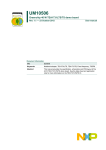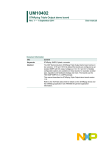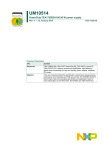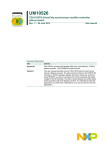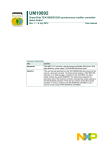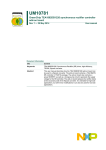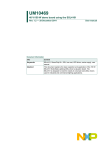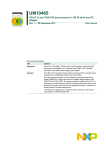Download UM10758 - NXP Semiconductors
Transcript
UM10758 TEA1836DB1094 TEA1836XT + TEA1792T 65 W notebook adapter Rev. 1 — 4 December 2013 User manual Document information Info Content Keywords TEA1836DB1094, TEA1836XT, very low standby power consumption, high peak power, active X-cap discharge, burst mode operation, flyback converter, 65 W, notebook adapter, controller, converter, power supply, demo board Abstract TheTEA1836XT is a high-featured low-cost DCM/QR flyback converter controller. It provides high efficiency at all power levels including very low no-load power consumption at nominal output voltage in burst mode operation. To minimize the risk of audible noise, burst mode operation is included for the low load range. Switching in the audible frequency range is limited and peak currents are low. The TEA1836XT is intended for power supplies up to 75 W with extra high peak power capabilities to enable supplying high peak power equipment without requiring a PFC. This document describes the 65 W notebook adapter demo board with the TEA1836XT and TEA1792TS. The demo board provides an output of 19.5 V/3.34 A. The average efficiency is above 91 % and the no-load power consumption is below 30 mW. UM10758 NXP Semiconductors TEA1836DB1094 TEA1836 + TEA1792 65 W notebook adapter Revision history Rev Date Description v.1 20131204 first issue Contact information For more information, please visit: http://www.nxp.com For sales office addresses, please send an email to: [email protected] UM10758 User manual All information provided in this document is subject to legal disclaimers. Rev. 1 — 4 December 2013 © NXP B.V. 2013. All rights reserved. 2 of 28 UM10758 NXP Semiconductors TEA1836DB1094 TEA1836 + TEA1792 65 W notebook adapter 1. Introduction WARNING Lethal voltage and fire ignition hazard The non-insulated high voltages that are present when operating this product, constitute a risk of electric shock, personal injury, death and/or ignition of fire. This product is intended for evaluation purposes only. It shall be operated in a designated test area by personnel qualified according to local requirements and labor laws to work with non-insulated mains voltages and high-voltage circuits. This product shall never be operated unattended. 1.1 Scope of this document This document describes the 65 W notebook adapter TEA1836DB1094 demo board using the TEA18361T and TEA1792TS. It contains a set of measurements that shows the main characteristics. 1.2 TEA1836XT The TEA1836XT is a controller IC for low-cost Switched Mode Power Supplies (SMPS) intended for flyback topologies. The built-in green functions provide high efficiency at all power levels. At high power levels the flyback operates in QR mode. When lowering the power levels, the controller switches to DCM or Frequency Reduction (FR) mode. The peak current is reduced to 25 % of the maximum peak current. At low power levels, when the flyback switching frequency reaches 25 kHz, the flyback converter switches to burst mode. To ensure high efficiency at low power and excellent no-load power performance, a burst mode has been integrated that reduces the optocurrent to a minimum level. As the switching frequency in this mode has a minimum value of 25 kHz while the burst frequency is always below 800 Hz, the frequencies are outside the audible range. During the non-switching phase of the burst mode, the internal IC supply current is reduced to further optimize efficiency. Valley switching is used in all operating modes. The TEA1836XT includes an OverPower Protection (OPP). The OPP enables the controller to deliver 150 % peak power for a limited amount of time (200 ms) in case of overpower situations. If the output is shorted, the output power is limited to 100 % to keep the average power consumption lower than 5 W. The TEA1836XT is realized in a high-voltage SOI (Silicon-On-Insulator) process. This process combines the advantages of a low-voltage process, like accuracy, high-speed protection functions, and control, while maintaining the high-voltage capabilities like high-voltage start-up and integrated X-cap discharge. The TEA1836XT enables low-cost, highly efficient and reliable supplies for power requirements up to 75 W to be designed easily and with a minimum number of external components. UM10758 User manual All information provided in this document is subject to legal disclaimers. Rev. 1 — 4 December 2013 © NXP B.V. 2013. All rights reserved. 3 of 28 UM10758 NXP Semiconductors TEA1836DB1094 TEA1836 + TEA1792 65 W notebook adapter 1.3 TEA1792TS The TEA1792TS is a member of the generation of Synchronous Rectifier (SR) controller ICs for switched mode power supplies. Its high level of integration enables the design of a cost-effective power supply with a very low number of external components. The TEA1792TS is a controller IC dedicated to synchronous rectification on the secondary side of discontinuous conduction mode and quasi-resonant flyback converters 1.4 Setup of the 65 W notebook adapter The board is designed for universal mains (90 V (AC) to 264 V (AC)). When a DC input voltage is applied, the power consumption is higher due to continuous activation of the X-capacitor discharge function. The demo board incorporates two subcircuits: • A DCM/QR type flyback converter • A Synchronous Rectifier (SR) The purpose of the demo board is to show the operation of the TEA1836XT and TEA1792TS in a single output supply. The performance is according today's general standards including the DoE + CoC efficiency requirements. It can be used as a starting point for further product development. 2. Safety warning The board must be connected to the mains voltage. Touching the board during operation must be avoided at all times. An isolated housing is obligatory when used in uncontrolled, non-laboratory environments. A galvanic isolation of the mains phase using a variable transformer is always recommended. Figure 1 shows the symbols by which these devices can be recognized. 019aab174 019aab173 a. Isolated Fig 1. UM10758 User manual b. Not isolated Variable transformer (Variac) isolation symbols All information provided in this document is subject to legal disclaimers. Rev. 1 — 4 December 2013 © NXP B.V. 2013. All rights reserved. 4 of 28 UM10758 NXP Semiconductors TEA1836DB1094 TEA1836 + TEA1792 65 W notebook adapter 3. Board photographs a. Top b. Bottom Fig 2. UM10758 User manual TEA1836XT and TEA1792TS demo board 65 W notebook adapter All information provided in this document is subject to legal disclaimers. Rev. 1 — 4 December 2013 © NXP B.V. 2013. All rights reserved. 5 of 28 UM10758 NXP Semiconductors TEA1836DB1094 TEA1836 + TEA1792 65 W notebook adapter 4. Specifications Table 1. Input specification Symbol Description Vi input voltage 90 V to 264 V fi input frequency 47 Hz to 64 Hz Pi(noload) no-load input power Table 2. Output sepcification Conditions Symbol Description Value at 230 V/50 Hz < 30 mW Condition Vo output voltage Value 19.5 V Io output current Io(peak) peak output current for 200 ms at Vi = 90 V at 60 Hz 5A 0 A to 3.33 A thold hold time at 115 V/60 Hz; full load > 10 ms - line regulation ±1 % - load regulation ±1 % tstartup start-up time at 115 V/60 Hz 1s efficiency DoE: > 88.5 % at cable end (including 0.5 % margin); CoC: > 89.5 % at cable end (including 0.5 % margin) 90 % - ElectroMagentic CISPR22 compliant Interference (EMI) pass 5. Measurements 5.1 Test facilities • • • • Oscilloscope: Yokogawa DL9140L AC Power Source: Agilent 6812B Electronic load: Agilent 6063B Digital power meter: Yokogawa WT210 5.2 Efficiency Efficiency measurements are performed at stabilized conditions. The output voltage and output current is measured directly at the PCB connector. Measurements are done for 115 V/60 Hz and 230 V/50 Hz. Table 3 shows the average value of 10 boards. Table 3. Efficiency results Condition ENERGY STAR 2.0 efficiency requirement (%) Average 100 % load 75 % load 50 % load 25 % load 115 V/60 Hz > 87 91.3 91.0 91.6 91.6 91.0 230 V/50 Hz > 87 91.4 92.2 91.7 91.3 90.5 UM10758 User manual All information provided in this document is subject to legal disclaimers. Rev. 1 — 4 December 2013 © NXP B.V. 2013. All rights reserved. 6 of 28 UM10758 NXP Semiconductors TEA1836DB1094 TEA1836 + TEA1792 65 W notebook adapter 5.3 Standby power consumption Power consumption performance of the total application board without load connected was measured with a Yokogawa WT210 digital power meter. Integration time was set to 5 minutes to measure the average dissipated power. Measurements were performed for 115 V/60 Hz, 230 V/50 Hz, and 264 V/50 Hz. Table 4 shows the average value of 10 boards. Table 4. Standby power consumption: No-load Condition ENERGY STAR 2.0 requirement (mW) No-load power consumption (mW) 115 V/60 Hz 300 21 230 V/50 Hz 300 24 264 V/50 Hz 300 27 5.4 Current for changing between normal and burst mode operation Table 5. Current for changing between normal and burst mode operation Condition 115 V/60 Hz 230 V/50 Hz From normal mode to burst mode operation current (A) 0.630 0.725 power (W) 12.3 14.1 From burst mode to normal mode operation current (A) 0.425 0.460 power (W) 8.3 9.0 5.5 Load regulation The output voltage versus load current was measured at the PCB connector. UM10758 User manual All information provided in this document is subject to legal disclaimers. Rev. 1 — 4 December 2013 © NXP B.V. 2013. All rights reserved. 7 of 28 UM10758 NXP Semiconductors TEA1836DB1094 TEA1836 + TEA1792 65 W notebook adapter DDD 9R 9 ,R$ (1) Vo = 115 V (2) Vo = 230 V Fig 3. Output voltage as a function of output current 5.6 Line regulation The output voltage versus mains input voltage was measured directly at the output connector for nominal load condition (3.34 A). The values remain within the target of 19.5 V 1 %. DDD 9R 9 Fig 4. 9LPDLQV9$& Output voltage as function of the mains voltage 5.7 Output voltage regulation in standby mode The output voltage regulation during no load operation was measured for 90 V/60 Hz and 264 V/50 Hz. UM10758 User manual All information provided in this document is subject to legal disclaimers. Rev. 1 — 4 December 2013 © NXP B.V. 2013. All rights reserved. 8 of 28 UM10758 NXP Semiconductors TEA1836DB1094 TEA1836 + TEA1792 65 W notebook adapter a. Vmains = 90 V at 60 Hz Fig 5. b. Vmains = 264 V at 50 Hz Output voltage regulation at no-load Table 6. Output voltage ripple at no-load condition Symbol 90 V/60 Hz 230 V/50 Hz Vripple (mV) 32 32 5.8 OverPower Protection (OPP) The continuous maximum peak output power was measured directly at the output connector for various mains input voltages. When this level is exceeded, the protection (stop and restart) is activated after the internal overpower counter passes 200 ms. DDD 3RFRQWPD[ : 3QRP : Fig 6. UM10758 User manual 9LPDLQV9$& Overpower protection level All information provided in this document is subject to legal disclaimers. Rev. 1 — 4 December 2013 © NXP B.V. 2013. All rights reserved. 9 of 28 UM10758 NXP Semiconductors TEA1836DB1094 TEA1836 + TEA1792 65 W notebook adapter 5.9 Voltage on pin VCC Table 7. VCC voltage Condition 115 V/60 Hz 230 V/50 Hz no-load 14.7 14.7 nominal load 18.3 16.8 5.10 Brownout and start-up level Table 8. VCC voltage Condition Brownout (V) Start level (V) no-load 77 84 nominal load 77 84 5.11 Short circuit protection Output short circuit directly at the PCB connectors before switching on the mains voltage or during operation. The system protects and restarts continuously during the short circuit condition. Table 9. Behavior during output short circuit condition Condition Behavior output short before applying AC mains voltage restart output short circuit during operation at full load and no-load restart Table 10. Condition 90 V/60 Hz 230 V/50 Hz 264 V/50 Hz input power 0.71 W 0.56 W 0.58 W Fig 7. UM10758 User manual Input power at output short circuit condition Short circuit during operation at Vmains = 230 V (AC) All information provided in this document is subject to legal disclaimers. Rev. 1 — 4 December 2013 © NXP B.V. 2013. All rights reserved. 10 of 28 UM10758 NXP Semiconductors TEA1836DB1094 TEA1836 + TEA1792 65 W notebook adapter 5.12 Overvoltage protection Applying a short circuit across the opto-LED of the optocoupler (U1B; see Figure 20) creates an output overvoltage condition. The overvoltage protection is triggered when the AUX pin voltage increases to 3 V during the OVP detection interval. The output voltage was measured directly at the output connector for both a nominal load (3.34 A) and a no-load condition. Table 11. Maximum output voltage at OVP Condition 115 V/60 Hz 230 V/50 Hz no-load 25.6 V 25.6 V nominal load (3.37 A) 25.1 V 25.1 V a. Io = 0 A Fig 8. b. Io = 3.34 A Maximum output voltage when OVP is triggered 5.13 Start-up time This is the time between the mains voltage switching on and the nominal output power available at the output. Table 12. Start-up time Condition Start-up time 90 V/60 Hz 400 ms 115 V/60 Hz 300 ms 230 V/50 Hz 150 ms 5.14 Start-up profile The shape of the output voltage during start-up was measured for 90 V/60 Hz and 264 V/50 Hz directly at the output connector for a no-load and a nominal load (3.34 A) condition. UM10758 User manual All information provided in this document is subject to legal disclaimers. Rev. 1 — 4 December 2013 © NXP B.V. 2013. All rights reserved. 11 of 28 UM10758 NXP Semiconductors TEA1836DB1094 TEA1836 + TEA1792 65 W notebook adapter a. Vmains = 90 V (AC) Fig 9. b. Vmains = 264 V (AC) Start-up at nominal output load a. Vmains = 90 V (AC) b. Vmains = 264 V (AC) Fig 10. Start-up at no output load 5.15 Hold-up time The hold-up time is defined as the time between the following moments: • After mains switch-off: The moment that the lowest bulk capacitor voltage during a mains cycle is crossed. • The moment that the output voltage starts to decrease. The hold-up time is measured for 115 V/60 Hz for a full load (3.34 A) condition. The output voltage was measured directly at the output connector. Table 13. UM10758 User manual Hold-up time Condition Hold-up time 115 V/60 Hz 13.5 ms All information provided in this document is subject to legal disclaimers. Rev. 1 — 4 December 2013 © NXP B.V. 2013. All rights reserved. 12 of 28 UM10758 NXP Semiconductors TEA1836DB1094 TEA1836 + TEA1792 65 W notebook adapter Fig 11. Hold-up time at Vmains = 115 V (AC) and full load condition (3.34 A) 5.16 Fast latch reset The fast latch reset time was measured. The fast latch reset time is the time that the voltage on pin VCC requires to drop to the reset level (8.65 V typical) when the mains voltage is disconnected. It is 750 ms. Fig 12. Latch reset when disconnecting mains voltage 5.17 X-capacitor discharge time Unplug the power line at no-load condition and measure the discharge time at the X-capacitor (330 nF). The discharge time is the time between the moment of disconnecting the mains source and the moment when the voltage reaches a defined voltage value. Table 14. UM10758 User manual X-capacitor discharge time test results Condition from 264 V * 2 to 135 V from 264 V * 2 to 60 V X-capacitor discharge time 55 ms 145 ms All information provided in this document is subject to legal disclaimers. Rev. 1 — 4 December 2013 © NXP B.V. 2013. All rights reserved. 13 of 28 UM10758 NXP Semiconductors TEA1836DB1094 TEA1836 + TEA1792 65 W notebook adapter Remark: The discharge can start 100 ms later (worse case) than measured and shown because in burst mode operation the mains measurement interval is approximately 100 ms (twait(burst)HV). Fig 13. X-capacitor discharge at 264 V (AC)/50 Hz and no-load 5.18 Dynamic load The output voltage was measured at the end of the board. Table 15. Maximum output voltage in case of OVP Condition Load Output voltage ripple (mV) 115 V/60 Hz Io: 0 % to 100 % 340 230 V/50 Hz Io: 0 % to 100 % 340 a. Vmains = 115 V (AC) b. Vmains = 230 V (AC) Fig 14. Output voltage during dynamic load UM10758 User manual All information provided in this document is subject to legal disclaimers. Rev. 1 — 4 December 2013 © NXP B.V. 2013. All rights reserved. 14 of 28 UM10758 NXP Semiconductors TEA1836DB1094 TEA1836 + TEA1792 65 W notebook adapter 5.19 Output ripple Output ripple was measured at the end of the cable using a standard filter of 1 F + 100 nF on the probing position. Output ripple and noise was measured at nominal output current (3.34 A) and at no-load condition (0 A). $GDSWHUFDEOH ) Q) 3UREH 3UREHWLS DDE Fig 15. Measurement setup a. Vmains = 90 V (AC) b. Vmains = 230 V (AC) Fig 16. Output voltage ripple nominal load Table 16. UM10758 User manual Output voltage ripple at nominal load Condition peak-to-peak output voltage ripple and noise 90 V/60 Hz 370 mV 230 V/50 Hz 220 mV All information provided in this document is subject to legal disclaimers. Rev. 1 — 4 December 2013 © NXP B.V. 2013. All rights reserved. 15 of 28 UM10758 NXP Semiconductors TEA1836DB1094 TEA1836 + TEA1792 65 W notebook adapter a. Vmains = 90 V (AC) b. Vmains = 230 V (AC) Fig 17. Output voltage ripple at burst mode operation (no-load) Table 17. Output voltage ripple at no-load Condition peak-to-peak output voltage ripple and noise 90 V/60 Hz 264 mV 230 V/50 Hz 264 mV 5.20 EMI performance Conditions: • • • • UM10758 User manual Type: Conducted EMI measurement Frequency range: 150 kHz to 30 MHz Output power: Full load condition Supply voltage: 115 V and 230 V All information provided in this document is subject to legal disclaimers. Rev. 1 — 4 December 2013 © NXP B.V. 2013. All rights reserved. 16 of 28 UM10758 NXP Semiconductors TEA1836DB1094 TEA1836 + TEA1792 65 W notebook adapter a. Curves b. Sheet Fig 18. Conducted EMI: Vmains = 115 V (AC) UM10758 User manual All information provided in this document is subject to legal disclaimers. Rev. 1 — 4 December 2013 © NXP B.V. 2013. All rights reserved. 17 of 28 UM10758 NXP Semiconductors TEA1836DB1094 TEA1836 + TEA1792 65 W notebook adapter a. Curves b. Sheet Fig 19. Conducted EMI: Vmains = 230 V (AC) 6. Schematic Figure 20 shows a set of functional jumper positions that is present on the demo board. By mounting a configuration of jumpers, the demo board can be used for a SO8 or a SO14 package of the TEA1836XT. The table shows the jumpers that require to be mounted for the preferred package. The demo board is standard equipped with a SO14 package and configuration. UM10758 User manual All information provided in this document is subject to legal disclaimers. Rev. 1 — 4 December 2013 © NXP B.V. 2013. All rights reserved. 18 of 28 xxxxxxxxxxxxxxxxxxxxx xxxxxxxxxxxxxxxxxxxxxxxxxx xxxxxxx x x x xxxxxxxxxxxxxxxxxxxxxxxxxxxxxx xxxxxxxxxxxxxxxxxxx xx xx xxxxx xxxxxxxxxxxxxxxxxxxxxxxxxxx xxxxxxxxxxxxxxxxxxx xxxxxx xxxxxxxxxxxxxxxxxxxxxxxxxxxxxxxxxxx xxxxxxxxxxxx x x xxxxxxxxxxxxxxxxxxxxx xxxxxxxxxxxxxxxxxxxxxxxxxxxxxx xxxxx xxxxxxxxxxxxxxxxxxxxxxxxxxxxxxxxxxxxxxxxxxxxxxxxxx xxxxxxxx xxxxxxxxxxxxxxxxxxxxxxxxx xxxxxxxxxxxxxxxxxxxx xxx ,1/(7 / %' .%3* $ 9 /) /) &; ) 1 ' 1 50 5 Nȍ 5 Nȍ 5 Nȍ & S) N9 & ) 9 ' 1 5 Nȍ 8 9&& 6(/5(* 7($76 & S) 9 QF 5 $8; Nȍ 5- &75/ ȍ & Q) 9 ) ) QF QF & ) 9 QF GULYHU ȍ QF 5- *1' ȍ QF 7($7 62 ȍ ȍ 5 ) 9 Nȍ 5 5 4 & ȍ QF &$ S) 9 *1' 5 & ) 9 QF =' %=;-%9 5 ȍ Nȍ) &$ S) 9 5 ȍ 5 Nȍ QF 8% /797% ) VHHVHOHFWLRQWDEOH ) +9 ' 9&& SDFNDJHVHOHFWLRQ 5- 60/ Q) 9 / 62 VHHVHOHFWLRQWDEOH 9 =' %=;-% QF 9 5- 9 5- 9 & ) 9 ) & ) 9 5 ȍ QF & Q) QF & ) 62 5 Nȍ 57 77&$) 5- & ) 9 & 5- ȍ QF 5- ȍ QF & ) 9 Q) 9 & S) 9 QF 5 5 9287 360153 %& 4 7.$' %$6 ) 5 Nȍ IO\ ' ,VHQVH 5 Nȍ 5 QF & 5 Q) 9 Nȍ 8 $6, & S) 9 QF ) 5 Nȍ &< 5 QF 8 $8; &75/ 3527(&7 +9 ,6(16( 7($7 *1' 62 S) %& 9&& 19 of 28 © NXP B.V. 2013. All rights reserved. Fig 20. Schematic diagram TEA1836XT and TEA1792TS demo board 65 W notebook adapter ) DDD UM10758 ) '5,9(5 TEA1836DB1094 TEA1836 + TEA1792 65 W notebook adapter Rev. 1 — 4 December 2013 All information provided in this document is subject to legal disclaimers. SURWHFW 8$ 5 ȍ 9 $ ' 6$0 QF 5- 5 Nȍ & S) 9 656(16( IO\ '5,9(5 5 Nȍ 8 ) 7 & Q) 9 *1' 5- ȍ ) NXP Semiconductors UM10758 User manual ' %$6+ UM10758 NXP Semiconductors TEA1836DB1094 TEA1836 + TEA1792 65 W notebook adapter 7. PCB layout a. Top b. Bottom Fig 21. Demo board PCB layout (copper tracks and areas) UM10758 User manual All information provided in this document is subject to legal disclaimers. Rev. 1 — 4 December 2013 © NXP B.V. 2013. All rights reserved. 20 of 28 UM10758 NXP Semiconductors TEA1836DB1094 TEA1836 + TEA1792 65 W notebook adapter 8. Bill Of Material (BOM) Table 18. TEA1836DB1094 bill of material Reference Description and values Part number Manufacturer BC1; BC2 bead - - BD1 bridge diode; flat/mini; 2 A; 600 V 2KBP206G LiteOn C1 capacitor; 120 F; 400 V; 105 C; 18 mm 30 mm; - KMG/NCC C2 capacitor; not connected; 220 pF; 100 V; 5 %; 0805; NPO; RoHS compliant - - C2A capacitor; leaded type; 1 nF; 100 V - - C3 capacitor; DIP; 3300 pF; 1 kV - - C4 capacitor; MLCC; 2200 pF; 630 V; 1206; Z5U - - C5; C6 capacitor; 680 F; 25 V; 105 C; 10 mm 16 mm - KZH/NCC C7 capacitor; MLCC; not connected; 0.1 F; 50 V; 10 %; 0805; X7R; RoHS compliant - - C7A1 capacitor; MLCC; 68 pF; 50 V; 10 %; 0805; X7R; RoHS compliant C8 capacitor; MLCC; 1 nF; 50 V; 10 %; 0805; X7R; lead free - - C9 capacitor; MLCC; not connected; 100 pF; 2 kV; 1206; Z5U - - C10 capacitor; MLCC; 0.1 F; 50 V; 10 %; 0805; X7R; RoHS compliant - C11 capacitor; MLCC; 0.22 F; 50 V; 10 %; 0805; X7R; lead free - - C12 capacitor; MLCC; not connected; 47 nF; 50 V; 10 %; 0805; X7R; RoHS compliant - - C13 capacitor; MLCC; 0.1 F; 50 V; 10 %; 0805; X7R; RoHS compliant - C14 capacitor; MLCC; 1 nF; 50 V; 10 %; 0603; X7R; RoHS compliant - - C15 capacitor; MLCC; 10 nF; 50 V; 10 %; 0805; X7R; RoHS compliant - C16 capacitor; electrolytic; KY/NCC; 10 F; 50 V; 105 C; 20 %; 5 mm 11.5 mm; - C17 capacitor; MLCC; not connected; 220 pF; 100 V; 0805; NPO; RoHS compliant - - C18 capacitor; MLCC; 47 nF; 50 V; 10 %; 0805; NPO; lead free - C19 capacitor; MLCC; 100 pF; 50 V; 10 %; 0805; X7R; RoHS compliant - UM10758 User manual - All information provided in this document is subject to legal disclaimers. Rev. 1 — 4 December 2013 © NXP B.V. 2013. All rights reserved. 21 of 28 UM10758 NXP Semiconductors TEA1836DB1094 TEA1836 + TEA1792 65 W notebook adapter Table 18. TEA1836DB1094 bill of material …continued Reference Description and values Part number Manufacturer CX1 X2-capacitor; MKP/R46; 0.33 F; 275 V (AC); 105 C; 18 mm 8.5 mm 14.5 mm; R46 - Arcotronics CY1 Y2-capacitor; 220 pF; 400 V (AC) - Murata D2; D4 single diode; DIS; 1000 V (RMS) 1N4007,DIP/DO41 - D3 single diode; DIS; 200 V (RMS) BAS21H,SMT/SOD123F NXP Semiconductors D5 single diode; DIS; 1000 V (RMS) SA2M,SMT/SMA Vishay D6 single diode; DIS; 100 V (RMS) BAS316,SMT/SOD323 NXP Semiconductors D7 single diode; DIS; 1000 V (RMS); current = 1 A; trr = 1.8 s S1ML Taiwan Semiconductor F1 fuse; DIP; 3.15 AT; 250 V; 8.35 mm 4.3 mm 7.7 mm; MST - - INLET1 inlet S3P,TU-333-BZ-315-P3D Texc-Unions L1 resistor; 0 ; 5 %; 0.25 W; 0805 - - LF1 CM choke; T12*6*4 (380 H) 0.69.5T:9.5T - - LF2 CM choke; T16*12*8(16.5 mH) 0.6 60T:60T - - Q1 n-channel MOSFET; RDSon = 0.62 ; Vgs(on) = 4 V; Id = 10 A; Ciss = 1350 pF; Vds = 600 V; Vgs = 30 V TK10A60D,SMT/TO220 Toshiba Q2 n-channel MOSFET; RDSon = 5.4 m; Vgs(on) = 3 V; Id = 100 A; Ciss = 6686 pF; Vds = 100 V; Vgs = 20 V PSMN7R0-100P,DIP/TO220 NXP Semiconductors R1; R23 resistor; 50 k; 1 %; 0.25 W; 1206 - - R2 resistor; not connected; 47 ; 5 %; 1/8 W; 0805 - - R3; R4 resistor; 43 k; 5 %; 0.25 W; 1206 - - R5 resistor; 43 k; 1 %; 1/8 W; 0805 - - R6 resistor; 470 ; 5 %; 1/8 W; 0805 - - R7 resistor; 6.8 k; 1 %; 1/8 W; 0805 - - R8 resistor; 4.7 ; 5 %; 1/8 W; 0805 - - R9 resistor; 10 ; 5 %; 1/8 W; 0805 - - R10 resistor; 1 k; 1 %; 1/8 W; 0805 - - R11 resistor; not connected; 1 k; 5 %; 1/8 W; 0805 - - R12 resistor; not connected; 470 ; 5 %; 1/8 W; 0805 - - R13 resistor; 20 k; 1 %; 1/8 W; 0805 - - R14 resistor; 165 k; 1 %; 1/8 W; 0805 - - R15 resistor; 2.2 k; 1 %; 1/8 W; 0805 - - R16 resistor; DIP; 0.15 ; 1 %; 1 W; arial lead; MOF - - R17 resistor; 10 k; 5 %; 1/8 W; 0805 - - R18 resistor; not connected; 47 ; 5 %; 1/8 W; 0805 - - UM10758 User manual All information provided in this document is subject to legal disclaimers. Rev. 1 — 4 December 2013 © NXP B.V. 2013. All rights reserved. 22 of 28 UM10758 NXP Semiconductors TEA1836DB1094 TEA1836 + TEA1792 65 W notebook adapter Table 18. TEA1836DB1094 bill of material …continued Reference Description and values Part number Manufacturer R19 resistor; 24 k; 1 %; 1/8 W; 0805 - - R20 resistor; 10 ; 5 %; 1/8 W; 0805 - - R21 resistor; 1 k; 5 %; 1/8 W; 0805 (modified connection) - - R24 resistor; 130 k; 1 %; 0.25 W; 1206 - - R25 resistor; <tbd> ; 1 %; 1/8 W; 0805 - - RJ1; RJ4; RJ7 resistor; 0 ; 5 %; 0.25 W; 1206 - - RJ3; RJ5; RJ6; R22 resistor; not connected; 0 ; 0.25 W; 1206 - - RT1 - TTC03A104F4192 - T1 transformer; flyback; RM10 - U1 QR flyback controller IC TEA18361T/SO14 NXP Semiconductors U2 IC Shunt regulator; adjustable precision shunt regulators AS431I,SMT/SOT23R BCD U3 DIS,SR,TEA1792TS TEA1792TS NXP Semiconductors U5 Photocoupler; 4-pins SOP; CTR = 130 %~ 260 %; 1 channel LTV-356TB LiteOn VOUT1 cable, 2.5 mm 5.5 mm 12 mm (kk,fk), L = 1200 mm 16AWG/1571 - ZD1 zener diode BZX84J-B8V2 - ZD2 zener diode; not connected BZX84J-B32 - 9. Transformer data 9.1 Introduction For this demo board, requirements were set to show high performance in a standard 65 W form factor board using a basic circuit configuration. To reach this goal, the transformer design requires extra attention to support the combination of high-efficiency performance while still being EMI compliant using a 220 pF Y-capacitor. At the same time the concept must deliver 65 W nominal output power and generate a peak output power that is 50 % higher. An RM10 core was used in combination with a customized bobbin type to build the transformer. UM10758 User manual All information provided in this document is subject to legal disclaimers. Rev. 1 — 4 December 2013 © NXP B.V. 2013. All rights reserved. 23 of 28 UM10758 NXP Semiconductors TEA1836DB1094 TEA1836 + TEA1792 65 W notebook adapter 9.2 Transformer data $ SDUWPXVWLQVHUWIXOO\WR VXUIDFH$LQUHFRPPHQGHGJULG PD[ PLQ PD[ PD[ [[ UHIHUHQFH ORWFRGH DQG GDWHFRGH WHUPLQDOQXPEHUVIRU UHIHUHQFHRQO\ 35, ) QF 656(& 6 6(& ) $8; UHFRPPHQGHG 3&SDWWHUQFRPSRQHQWVLGH 'LPHQVLRQVLQPP DDD Fig 22. Transformer data Table 19. Transformer electrical specifications at 25 C unless otherwise noted Feature Value DC resistance (at 20 C) 1 to 2: 0.440 ; 10 % Comment 10 to 12: 0.282 ; 10 % S to F1: 0.178 ; 10 % S to F2: 0.033 ; 20 % dielectric rating UM10758 User manual 3000 V (AC) tested 1 minute by applying 3750 V (AC) for 1 s between pins 1 and S (tie 2 + 10) 500 V (AC) tested 1 minute by applying 625 V (AC) for 1 s between pins 1 and 12 inductance 340 H; 3 %; 10 kHz; 100 mV (AC); 0 mA (DC); 10 to 12; Ls saturation current 5A saturating current that causes 20 % rolloff from initial inductance All information provided in this document is subject to legal disclaimers. Rev. 1 — 4 December 2013 © NXP B.V. 2013. All rights reserved. 24 of 28 UM10758 NXP Semiconductors TEA1836DB1094 TEA1836 + TEA1792 65 W notebook adapter Table 19. Transformer electrical specifications at 25 C unless otherwise noted …continued Feature Value Comment leakage inductance 7.5 H (maximum); 100 kHz; 100 mV (AC) 10 to 12 (tie 1 + 2, S + F1 + F2); Ls turns ratio (10 to 12) : (1 to 2), (6.29) : (1.00), 1 % (10 to 12) : (S to F1), (3.67) : (1.00); 1 % (10 to 12) : (S to F2), (5 to 5) : (1.00); 1 % 9.3 Transformer winding construction WKHGRWLQGLFDWHVWKHZLQGLQJGLUHFWLRQ $8; ò35,0 6+,(/'PHWDOIRLO 6(& 656(& 6+,(/'ZLQGLQJ ò35,0 LQVXODWLRQWDSH DDD Fig 23. Transformer winding construction UM10758 User manual All information provided in this document is subject to legal disclaimers. Rev. 1 — 4 December 2013 © NXP B.V. 2013. All rights reserved. 25 of 28 UM10758 NXP Semiconductors TEA1836DB1094 TEA1836 + TEA1792 65 W notebook adapter 10. Abbreviations Table 20. Abbreviations Acronym Description BCM Boundary Conduction Mode DCM Discontinuous Conduction Mode EMI ElectroMagnetic Interference MOSFET Metal-Oxide Semiconductor Field-Effect Transistor OCP OverCurrent Protection OPP OverPower Protection OVP OverVoltage Protection OLP Open-Loop Protection PCB Printed-Circuit Board QR Quasi Resonant RMS Root Mean Square SOI Silicon-On-Insulator SR Synchronous Rectification 11. References UM10758 User manual [1] TEA18361LT — Data sheet - GreenChip SMPS control IC [2] TEA18361T — Data sheet - GreenChip SMPS control IC [3] TEA18362LT — Data sheet - GreenChip SMPS control IC [4] TEA18362T — Data sheet - GreenChip SMPS control IC [5] TEA18363LT — Data sheet - GreenChip SMPS control IC [6] TEA18363T — Data sheet - GreenChip SMPS control IC [7] AN11403 — Application note TEA1836X [8] TEA1792TS — Data sheet - GreenChip synchronous rectifier controller [9] AN11149 — Application note - TEA1792 GreenChip synchronous rectifier controller All information provided in this document is subject to legal disclaimers. Rev. 1 — 4 December 2013 © NXP B.V. 2013. All rights reserved. 26 of 28 UM10758 NXP Semiconductors TEA1836DB1094 TEA1836 + TEA1792 65 W notebook adapter 12. Legal information 12.1 Definitions Draft — The document is a draft version only. The content is still under internal review and subject to formal approval, which may result in modifications or additions. NXP Semiconductors does not give any representations or warranties as to the accuracy or completeness of information included herein and shall have no liability for the consequences of use of such information. NXP Semiconductors does not accept any liability related to any default, damage, costs or problem which is based on any weakness or default in the customer’s applications or products, or the application or use by customer’s third party customer(s). Customer is responsible for doing all necessary testing for the customer’s applications and products using NXP Semiconductors products in order to avoid a default of the applications and the products or of the application or use by customer’s third party customer(s). NXP does not accept any liability in this respect. Export control — This document as well as the item(s) described herein may be subject to export control regulations. Export might require a prior authorization from competent authorities. 12.2 Disclaimers Limited warranty and liability — Information in this document is believed to be accurate and reliable. However, NXP Semiconductors does not give any representations or warranties, expressed or implied, as to the accuracy or completeness of such information and shall have no liability for the consequences of use of such information. NXP Semiconductors takes no responsibility for the content in this document if provided by an information source outside of NXP Semiconductors. In no event shall NXP Semiconductors be liable for any indirect, incidental, punitive, special or consequential damages (including - without limitation - lost profits, lost savings, business interruption, costs related to the removal or replacement of any products or rework charges) whether or not such damages are based on tort (including negligence), warranty, breach of contract or any other legal theory. Notwithstanding any damages that customer might incur for any reason whatsoever, NXP Semiconductors’ aggregate and cumulative liability towards customer for the products described herein shall be limited in accordance with the Terms and conditions of commercial sale of NXP Semiconductors. Right to make changes — NXP Semiconductors reserves the right to make changes to information published in this document, including without limitation specifications and product descriptions, at any time and without notice. This document supersedes and replaces all information supplied prior to the publication hereof. Suitability for use — NXP Semiconductors products are not designed, authorized or warranted to be suitable for use in life support, life-critical or safety-critical systems or equipment, nor in applications where failure or malfunction of an NXP Semiconductors product can reasonably be expected to result in personal injury, death or severe property or environmental damage. NXP Semiconductors and its suppliers accept no liability for inclusion and/or use of NXP Semiconductors products in such equipment or applications and therefore such inclusion and/or use is at the customer’s own risk. Applications — Applications that are described herein for any of these products are for illustrative purposes only. NXP Semiconductors makes no representation or warranty that such applications will be suitable for the specified use without further testing or modification. Customers are responsible for the design and operation of their applications and products using NXP Semiconductors products, and NXP Semiconductors accepts no liability for any assistance with applications or customer product design. It is customer’s sole responsibility to determine whether the NXP Semiconductors product is suitable and fit for the customer’s applications and products planned, as well as for the planned application and use of customer’s third party customer(s). Customers should provide appropriate design and operating safeguards to minimize the risks associated with their applications and products. Evaluation products — This product is provided on an “as is” and “with all faults” basis for evaluation purposes only. NXP Semiconductors, its affiliates and their suppliers expressly disclaim all warranties, whether express, implied or statutory, including but not limited to the implied warranties of non-infringement, merchantability and fitness for a particular purpose. The entire risk as to the quality, or arising out of the use or performance, of this product remains with customer. In no event shall NXP Semiconductors, its affiliates or their suppliers be liable to customer for any special, indirect, consequential, punitive or incidental damages (including without limitation damages for loss of business, business interruption, loss of use, loss of data or information, and the like) arising out the use of or inability to use the product, whether or not based on tort (including negligence), strict liability, breach of contract, breach of warranty or any other theory, even if advised of the possibility of such damages. Notwithstanding any damages that customer might incur for any reason whatsoever (including without limitation, all damages referenced above and all direct or general damages), the entire liability of NXP Semiconductors, its affiliates and their suppliers and customer’s exclusive remedy for all of the foregoing shall be limited to actual damages incurred by customer based on reasonable reliance up to the greater of the amount actually paid by customer for the product or five dollars (US$5.00). The foregoing limitations, exclusions and disclaimers shall apply to the maximum extent permitted by applicable law, even if any remedy fails of its essential purpose. Safety of high-voltage evaluation products — The non-insulated high voltages that are present when operating this product, constitute a risk of electric shock, personal injury, death and/or ignition of fire. This product is intended for evaluation purposes only. It shall be operated in a designated test area by personnel that is qualified according to local requirements and labor laws to work with non-insulated mains voltages and high-voltage circuits. The product does not comply with IEC 60950 based national or regional safety standards. NXP Semiconductors does not accept any liability for damages incurred due to inappropriate use of this product or related to non-insulated high voltages. Any use of this product is at customer’s own risk and liability. The customer shall fully indemnify and hold harmless NXP Semiconductors from any liability, damages and claims resulting from the use of the product. Translations — A non-English (translated) version of a document is for reference only. The English version shall prevail in case of any discrepancy between the translated and English versions. 12.3 Trademarks Notice: All referenced brands, product names, service names and trademarks are the property of their respective owners. GreenChip — is a trademark of NXP B.V. UM10758 User manual All information provided in this document is subject to legal disclaimers. Rev. 1 — 4 December 2013 © NXP B.V. 2013. All rights reserved. 27 of 28 UM10758 NXP Semiconductors TEA1836DB1094 TEA1836 + TEA1792 65 W notebook adapter 13. Contents 1 1.1 1.2 1.3 1.4 2 3 4 5 5.1 5.2 5.3 5.4 5.5 5.6 5.7 5.8 5.9 5.10 5.11 5.12 5.13 5.14 5.15 5.16 5.17 5.18 5.19 5.20 6 7 8 9 9.1 9.2 9.3 10 11 12 12.1 12.2 12.3 13 Introduction . . . . . . . . . . . . . . . . . . . . . . . . . . . . 3 Scope of this document . . . . . . . . . . . . . . . . . . 3 TEA1836XT . . . . . . . . . . . . . . . . . . . . . . . . . . . 3 TEA1792TS . . . . . . . . . . . . . . . . . . . . . . . . . . . 4 Setup of the 65 W notebook adapter . . . . . . . . 4 Safety warning . . . . . . . . . . . . . . . . . . . . . . . . . . 4 Board photographs . . . . . . . . . . . . . . . . . . . . . . 5 Specifications. . . . . . . . . . . . . . . . . . . . . . . . . . . 6 Measurements . . . . . . . . . . . . . . . . . . . . . . . . . . 6 Test facilities . . . . . . . . . . . . . . . . . . . . . . . . . . . 6 Efficiency . . . . . . . . . . . . . . . . . . . . . . . . . . . . . 6 Standby power consumption. . . . . . . . . . . . . . . 7 Current for changing between normal and burst mode operation. . . . . . . . . . . . . . . . . 7 Load regulation . . . . . . . . . . . . . . . . . . . . . . . . . 7 Line regulation . . . . . . . . . . . . . . . . . . . . . . . . . 8 Output voltage regulation in standby mode . . . 8 OverPower Protection (OPP) . . . . . . . . . . . . . . 9 Voltage on pin VCC . . . . . . . . . . . . . . . . . . . . 10 Brownout and start-up level . . . . . . . . . . . . . . 10 Short circuit protection . . . . . . . . . . . . . . . . . . 10 Overvoltage protection . . . . . . . . . . . . . . . . . . 11 Start-up time . . . . . . . . . . . . . . . . . . . . . . . . . . 11 Start-up profile . . . . . . . . . . . . . . . . . . . . . . . . 11 Hold-up time . . . . . . . . . . . . . . . . . . . . . . . . . . 12 Fast latch reset . . . . . . . . . . . . . . . . . . . . . . . . 13 X-capacitor discharge time . . . . . . . . . . . . . . . 13 Dynamic load . . . . . . . . . . . . . . . . . . . . . . . . . 14 Output ripple . . . . . . . . . . . . . . . . . . . . . . . . . . 15 EMI performance . . . . . . . . . . . . . . . . . . . . . . 16 Schematic . . . . . . . . . . . . . . . . . . . . . . . . . . . . . 18 PCB layout . . . . . . . . . . . . . . . . . . . . . . . . . . . . 20 Bill Of Material (BOM) . . . . . . . . . . . . . . . . . . . 21 Transformer data . . . . . . . . . . . . . . . . . . . . . . . 23 Introduction. . . . . . . . . . . . . . . . . . . . . . . . . . . 23 Transformer data . . . . . . . . . . . . . . . . . . . . . . 24 Transformer winding construction. . . . . . . . . . 25 Abbreviations . . . . . . . . . . . . . . . . . . . . . . . . . . 26 References . . . . . . . . . . . . . . . . . . . . . . . . . . . . 26 Legal information. . . . . . . . . . . . . . . . . . . . . . . 27 Definitions . . . . . . . . . . . . . . . . . . . . . . . . . . . . 27 Disclaimers . . . . . . . . . . . . . . . . . . . . . . . . . . . 27 Trademarks. . . . . . . . . . . . . . . . . . . . . . . . . . . 27 Contents . . . . . . . . . . . . . . . . . . . . . . . . . . . . . . 28 Please be aware that important notices concerning this document and the product(s) described herein, have been included in section ‘Legal information’. © NXP B.V. 2013. All rights reserved. For more information, please visit: http://www.nxp.com For sales office addresses, please send an email to: [email protected] Date of release: 4 December 2013 Document identifier: UM10758





























